First Special Service Force, 1942-1944
First Special Service Force
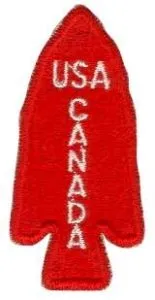
The First Special Service Force, a Joint U.S.-Canadian Fighting Unit: The insignia of the First Special Service Force, composed of US and Canadian soldiers in training at Ft. William Henry Harrison, Montana, is an Indian spearhead of deep red with the “USA” and “Canada” forming a white T against the background. The patch is worn on the left shoulder of the soldier, who is shown here sewing the coveted emblem to his blouse. The braided cord, of red, white and blue also signifies the wearer as a member of “the force.” 1943.
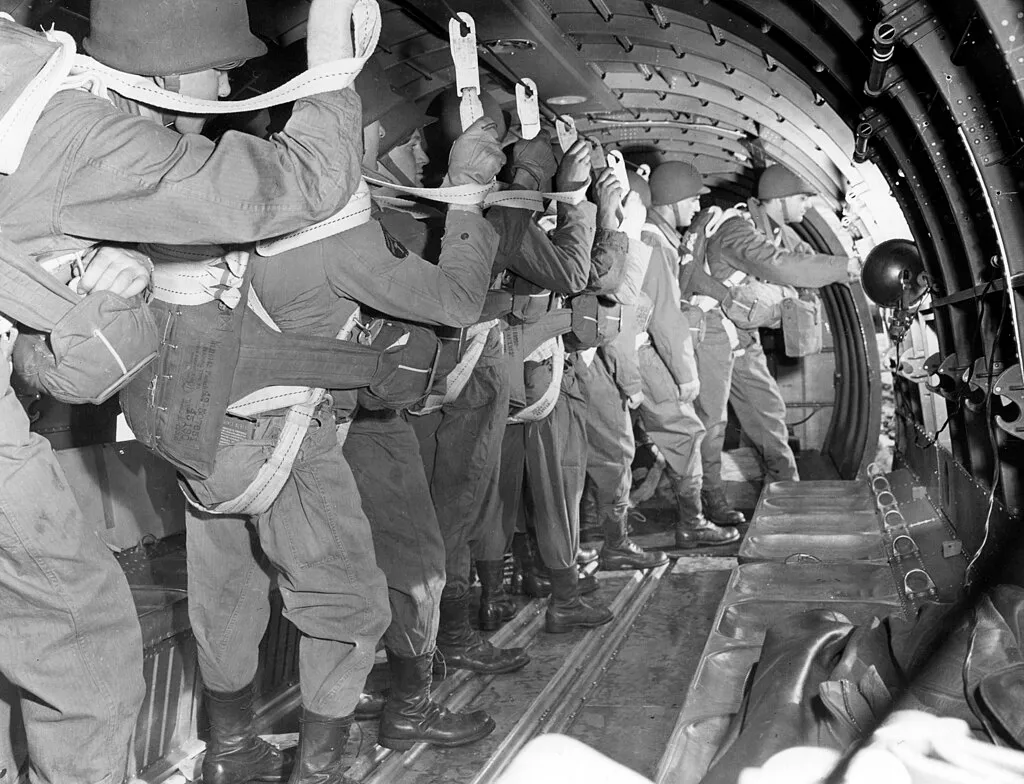
(U.S. Army Signal Corps Archive Photo)
Paratroop field surgeons all lined up, ready for their first jump at the Ft. William Henry Harrison training center of the joint U.S. Canadian First Special Service Force. 1943.
The Canadian Airborne Regiment drew much inspiration from the history of the First Special Service Force. The Regiment bears the FSSF battle honours Monte Camino, Monte Majo, Monte La Difensa/Monte La Remetanea, Anzio and Rome on its Regimental Colour. As well the unconventional nature of the First Special Service Force, similar to the British SAS and the current U.S. Army Special Forces and elsewhere, was not replicated in the more conventional role of the Canadian Airborne Regiment. Nevertheless, its accomplishments served as a model for many members of the new "Airborne".
The First Special Service Force was a unique joint formation of Canadian and American troops assigned to perform sabotage operations in Europe in the Second World War. Simply named "special forces" to conceal its "commando" or "ranger" purpose, this unit later gained fame as the "Devil's Brigade". The Canadians were designated the "2nd Canadian Parachute Battalion".
Members were handpicked and sent to Fort William Henry Harrison, Helena, Montana, for special training. The Canadians wore American uniforms and equivalent ranks to eliminate any questions of command among the troops. Their work-up took place in three phases, with extensive physical training throughout the program. The first phase included parachute training, small unit tactics and weapons handling—all officers and ranks were required to master the full range of infantry weapons from pistols and carbines to bazookas and flame throwers. Next came explosives handling and demolition techniques, then a final phase consisted of skiing, rock climbing, adapting to cold weather, and operation of the Weasel combat vehicle. Exercises in amphibious landings and beach assaults were added later.
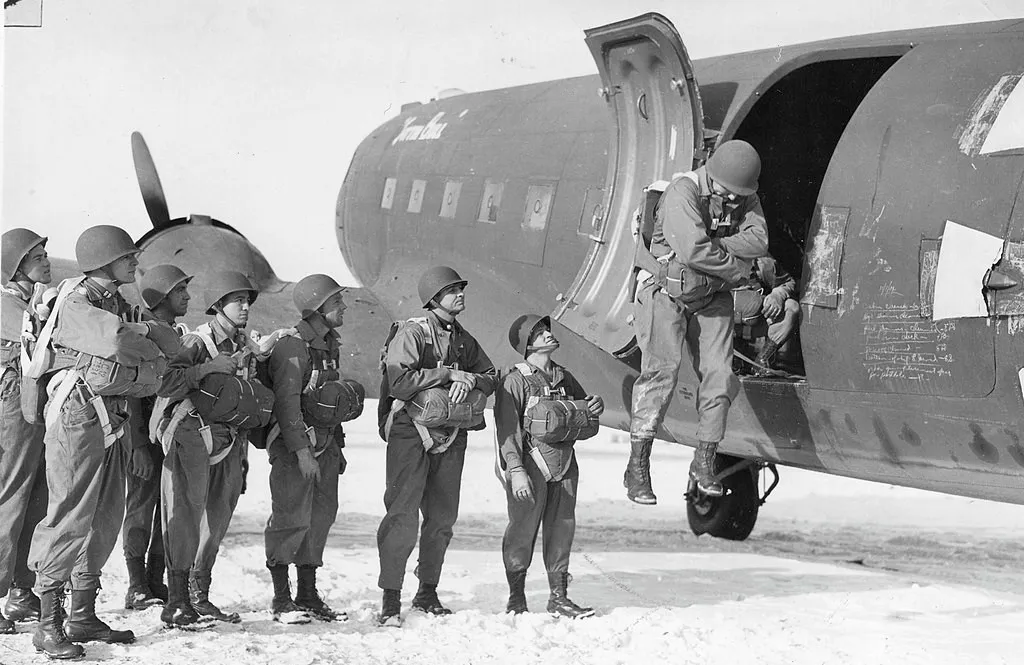
(U.S. Army Signal Corps Archive Photo)
Capt. George F. Evashwick, Turtle Creek, Pennsylvania, a paratrooper field surgeon, is practicing an exit from a Douclas C-47 transport, while other doctors look on and wait their turn. 1943.
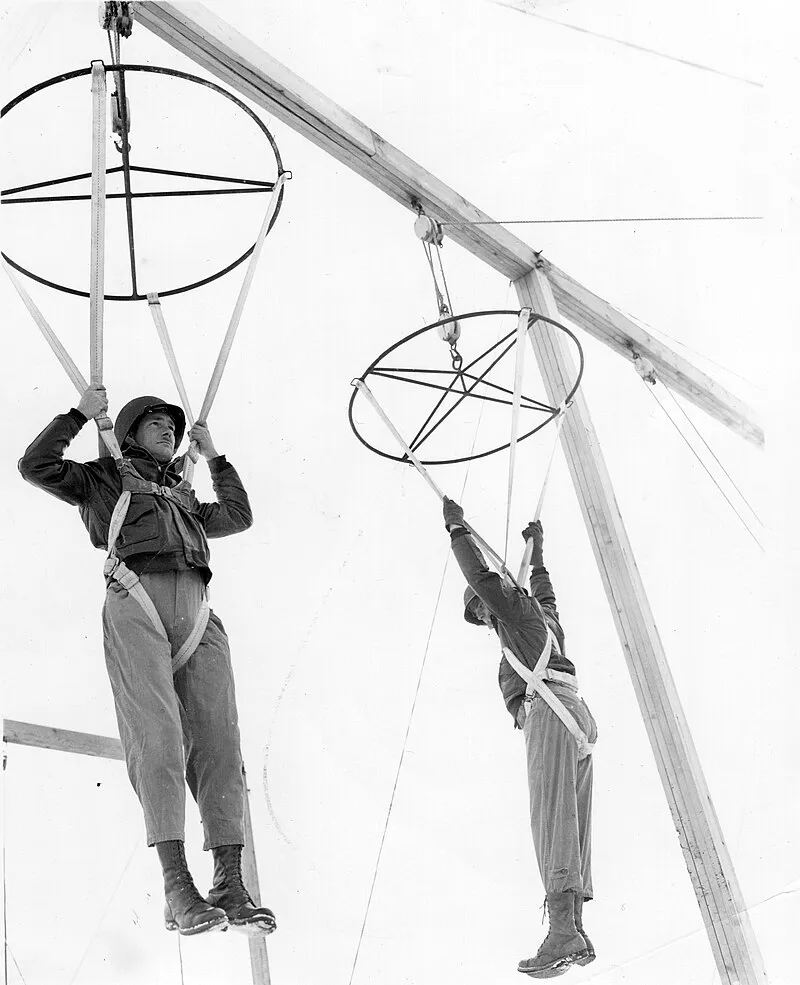
(U.S. Army Signal Corps Archive Photo)
Canadian and American paratroopers of the First Special Service Force undergoing parachute training at Fort William Henry Harrison, Montana. Before their first actual jump from a C-47 transport, members of the First Special Service Force are thoroughly oriented to the feel of a parachute by wearing the practice harness shown here.

(Library and Archives Canada Photo, MIKAN No. 3378674)
First Special Service Force paratroopers boarding a Douglas C-47 Skytrain for a jump at Fort William Henry Harrison, Montana, in 1942.

(Library and Archives Canada Photo, MIKAN No. 3378685)
Forceman of the First Special Service Force preparing rations in an improvised shelter during cold weather survival training, Blossburg, Montana, United States, January 1943.

(Library and Archives Canada Photo, MIKAN No. 3262661)
Canadian Infantrymen of the 13th Infantry Brigade Group, embarking in an American troopship to take part in Operation Cottage, the invasion of Kiska, July 1943.
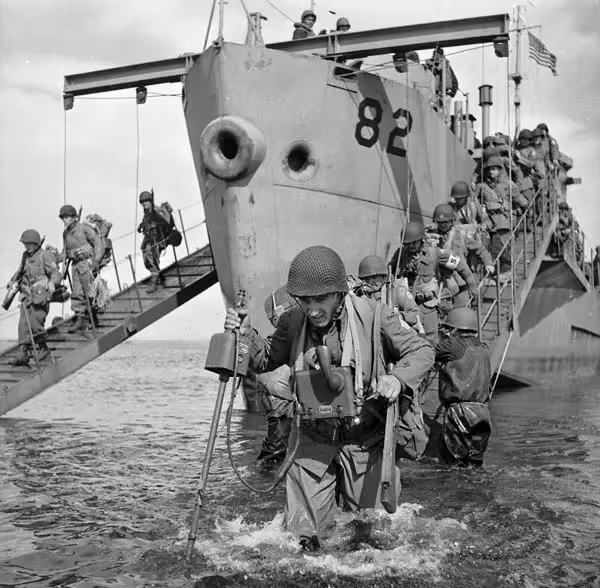
(Library and Archives Canada Photo, MIKAN No. 3211083)
Canadian Infantrymen of the 13th Infantry Brigade Group, landing at Kiska in the Aleutian Islands, Alaska on Op COTTAGE, 16 Aug 1943.
It was decided that the FSSF would be blooded against the Japanese forse occupying the Aleutian island of Kiska. The FSSF arrived at the San Francisco Port of Embarkation on 4 July 1943, and sailed for the Aleutian Islands on 10 July 1943. On 15 August 1943, 1st SSF was part of the invasion force of the island of Kiska, but after discovering the island was recently evacuated by Japanese forces, it re-embarked and left ship at Camp Stoneman, California. The FSSF returned to Fort Ethan Allen, arriving 9 September 1944.
The FSSF was sent to Italy where it was reassigned to the United States 5th Army, which was fighting its way north through the rugged mountainous terrain of Italy. German forces entrenched in two mountains were inflicting heavy casualties on the 5th US Army. After a 12 day attack was stopped cold at Monte la Difensa, the Force went in and cleared the veteran German 104th Panzergrenadier Regiment from the summit, a feat immortalized in the 1968 motion picture The Devil's Brigade.
The first regiment with 600 men, had scaled a 1,000-foot (300 m) cliff by night to surprise the enemy position. Planned as a three- to four-day assault, the battle was won in just two hours. The force remained for three days, packing in supplies for defensive positions and fighting frostbite, then moved on to the second mountain, Monte Majo, which was soon overtaken. In the end, FSSF suffered 511 casualties including 73 dead and 116 exhaustion cases. The commander, Colonel Robert Frederick, was wounded twice himself.

General Frederick, the FSSF commander, had these cards printed up with the unit's insignia on them and the words Das dicke Ende kommt noch! or "The worst is yet to come" printed in red ink. The force would leave these cards on the bodies of dead Germans as a form of psychological warfare.
The 1st Special Service Battalion on the Riviera

Extracts from the Official History of the Canadian Army in the Second World War, Volume II, The Canadians in Italy 1943-1945, By LCol Gerald W. L. Nicholson, Deputy Director, Historical Section, General Staff Maps drawn by Captain C. C. J. Bond, Published by Authority of the Minister of National Defence, Edmond Cloutier, C.M.G., O.A., D.S.P., Ottawa, 1956, Queen's Printer and Controller of Stationery. p. 666-671.
Stacey, C.P. History of the Canadian Army in the Second World War: Volume III: The Victory Campaign: The Operations in North-west Europe 1944-45 (Queen's Printer, Ottawa, ON, 1960). p.141.
The troops who sailed from Italy in mid-February in the opening stages of "Operation Goldflake" were not the first Canadians to leave the Mediterranean theatre. The previous December had seen the disbandment of the 1st Canadian Special Service Battalion, which as a component of the First Special Service Force had found itself consistently pursuing a course apart from the main body of Canadian troops. After the capture of Rome the joint Canadian American Force had left the Fifth Army to prepare for the Allied assault upon Southern France, the code name of which for greater security was changed early in July from "Anvil" to "Dragoon".
After a brief rest on the pleasant shores of LakeAlbano,163 twelve miles south-east of Rome (Map 15), the Force carried out six weeks of intensive "invasion" training at Santa Maria di Castellabate, at the south end of the Gulf of Salerno.164 This gruelling period of preparation ended with a rehearsed landing, conducted in company with a French commando group, on the Pontine Islands, 60 miles off the Naples coast. On 11 August the Force embarked for a staging area in Corsica.
Detailed planning for "Dragoon" had been going forward since the beginning of March at Major-General Alexander M. Patch's Seventh Army Headquarters, which until4 July was designated for security reasons "Force 163". The final pattern of invasion called for an assault landing east of Marseilles by Major-General Truscott's 6th Corps(the 3rd, 36th and 45th U.S. Divisions), assisted by French commando forces and backed by overwhelming naval and air support. The immediate "follow-up" would bring in the French 2nd Corps (composed of divisions formerly with the Corps Expeditionnaire Francais) under General de Lattre de Tassigny, who as the build-up proceeded would assume his original position as G.O.C.-in-C. Army "B"* with two French corps under his command. Prior to the 6th Corps' landings the First Special Service Force, operating directly under the Seventh Army, was to remove a threat to the left flank by capturing the German-held islands of Levant and Port Cros, the two eastern most of the Iles d'Hyeres, seven miles off the French coast.
The main amphibious assault was delivered at 8:00 a.m. on 15 August by the three American divisions on a fifteen-mile front between Toulon and Cannes, the landings being watched by Mr. Churchill from the deck of a British destroyer. Earlier that morning more than 5000 troops of a combined British-American Airborne Task Force †hat had dropped by parachute some ten miles inland to block the enemy's reinforcement routes from the interior. Extensive glider-landings followed; in all 9,000 airborne personnel were carried over from the Rome airfields into the bridgehead.
The honour of making the first sea landing on the French mainland fell to the French commando troops, who were carried to their assignment on HMCS Prince (David or Henry) In April 1944 the French Committee of National Liberation had confirmed General de Lattre's appointment to command Army "B", consisting of "all the French land forces summoned for the landing in the south of France."167 The arrangement subsequently agreed upon by A.F.H.Q. and General de Gaulle left General Patch's Seventh Army with sole direction of the planning of "Anvil" and the initial phase of the operation, while assuring de Lattre of his full Army Command when the time was appropriate. On September he took over Army "B", which ten days later became the First French Army. This force had been organized and was commanded by Major-General R. T. Frederick. Composed of units formerly comprising the Seventh Army Provisional Airborne Division, on 15 August it became the 1st Airborne Task Force. Frederick was succeeded in the command of the First Special Service Force by Colonel E. A. Walker. HMCS Prince David, and HMCS Prince Henry were two Canadian Landing Ships Infantry sharing in Operation "Dragoon".
Shortly before midday on the 14th the First Special Service Force sailed from Corsica aboard HMCS Prince Henry, HMS Prince Baudouin, and five transport destroyers, escorted by five American torpedo boats. Before midnight the ships had taken station about three miles south of the Hyeres, and in the early hours of the first anniversary of the Kiska enterprise the troops began paddling ashore in inflated rubber dinghies, which assault landing craft had quietly towed to within a quarter of a mile of land. Resistance on the island of Levant was overcome without much trouble. The 2nd and 3rd Regiments (the latter commanded by a Canadian, LCol. R. W. Becket) beached on the east shore, and scaling eighty-foot cliffs overran the five-mile length of the island, finding the eastern battery merely wooden guns manned by stuffed dummies. Before the end of D Day Force Headquarters had landed and the fighting on Levant was over. A mile to the west the smaller Port Cros proved more formidable. Roping their way up the vertical cliffs battalions of the 1st Special Service Regiment, led by LCol. Akehurst, occupied the eastern half of the island without difficulty, but were stopped by a cluster of forts in the port area. Most formidable of these was Fort de I'Eminence, a Napoleonic stronghold with twelve feet of concrete and rock protecting the sides and top of its central chamber. Rounds from the eight-inch guns of the cruiser USS Augusta caromed off like ping-pong balls. Rockets from sixteen B-26 Marauder aircraft made no impression. Heavy bombers were not available, and it was not until the afternoon of the 17th, when the battleship HMS Ramillies steamed up to put a dozen 15-inch shells into the target, that the battle ended abruptly. Canadian casualties in the capture of the two islands numbered 10 killed and 32 wounded.
Relieved by French garrison troops, the Special Service Force moved over to the mainland and on 21 August re-entered operations just west of Cannes, where it replaced the 2nd Parachute Brigade, the British component of the First Airborne Task Force. While the main Franco-American forces (which on 16 September became the 6th Army Group* under LGen Jacob L. Devers) drove the German Nineteenth Army northward through the Rhone valley, the Special Service regiments began a series of rapid advances along the Riviera coast that was to bring them in less than three weeks almost to the Italian boundary, a distance of some 45 miles. They pushed eastward on foot against light opposition on a front ten miles wide-each day expanding its quota of two or three towns liberated, a number of machine-gun positions destroyed, and a score or so of prisoners captured. During the first week the briskest fighting took place on 25 August for possession of Villeneuve Loubet, a town on the Loup River, ten miles east of Cannes.
The pursuit continued with the Canadians and Americans close on the heels of the retreating Germans. At a small inn east of the Loup Colonel Walker and his staff signed the register immediately below the signatures of LGen Fretter-Pico, G.O.C. 148th Division, and his staff, "who had checked out hurriedly the previous evening." Prior to this date (on which command of the enterprise passed from General Wilson to General Eisenhower), General Devers' Headquarters was designated Advance Allied Force Headquarters Detachmentthe On the 30th the Force forded the Var River without incident; but here the narrow coastal plain ended, and resistance stiffened amid the mountains behind Nice. Up to this point the Special Service Force,advancing under the command of the First Airborne Task Force, had been flanked on either side by American airborne units, but on 3 September the 2nd Regiment relieved the 509th Parachute Infantry Battalion immediately west of Monaco (special orders were issued against entering the principality), and thence forward the coastal sector was included in Colonel Walker's commitments.
Three days later patrols into Menton, only two miles from the international boundary, found the city evacuated, and by the 9th the Force had taken up positions which they were to hold unchanged for the next seven weeks. The German 34th Division, which had replaced the 148th, was firmly ensconced in the fortifications of the Little Maginot Line, where the French had blunted the Italian invasion in 1940. Aided by fire from American destroyers and the French battleship Lorraine, Special Service regiments reduced these forts one by one, Fort Castillon, five miles north of Menton, alone putting up a prolonged fight. When it fell at the end of October the enemy withdrew across the Italian border.
By this time General Devers' armies were far to the north, fighting in the Vosges Mountains preparatory to essaying a break through the Belfort Gap to the Rhine. For the forces on the Mediterranean coast, however, the campaign seemed to be petering out in a long and unpleasant anti-climax, as they found themselves "sitting up on the mountains day after day", exposed to cool, wet weather that contradicted all popular conceptions regarding the climate of the sunny Riviera. There were no regrets among the First Special Service Force when it was relieved on 28 November by Japanese American troops of the 442nd Regimental Combat Team. The First Airborne Task Force had already been disbanded, and its parachutists had gone north to reinforce formations of the First Allied Airborne Army.
For the Special Service Force, General Eisenhower's headquarters had no requirement which would enable it to preserve its identity. At the Quebec Conference in September General Marshall had pointed to the availability of the "Plough" force for winter operations in the Alps, but no such role had materialized. As its name indicates, the Force was a highly specialized assault team, even though, as we have seen, it had fought for considerable periods as normal infantry. That it should continue to be employed in a general role was inevitably regarded by many as a military waste. As early as January 1944, when the provision of suitably trained reinforcements was creating a difficult problem in Ottawa, the withdrawal of the Canadian component had been seriously considered on both sides of the Atlantic.
The Canadian viewpoint was that the special type of training which the Canadian personnel had received could "be used to better advantage for the common cause in prospective operations beig planned for the forces in the United Kingdom." A Canadian withdrawal, however, would have meant breaking up the Force, which was then fighting in the Anzio bridgehead. Neither the Combined Chiefs of Staff nor the Commanders in the Mediterranean favoured such a course. Accordingly arrangements were made to reinforce both the Canadian and United States elements with non-parachutists. By October, however, the feeling in Ottawa had grown that "the continued employment of this Special Force on operations detached from those upon which the main forces of the Canadian Army were employed constituted a dispersion of our forces for which there is no special necessity." When, therefore, the Department of National Defence learned from Washington that SHAEF recommended the disbandment of the First Special Service Force, it immediately gave its approval.
On 5 December the Canadian members of the Force paraded past their American comrades in a final salute at Villeneuve Loubet, and shortly afterwards embarked at Marseilles for Italy. Their operational tour in France had lasted 107 days, during which Canadian casualties had numbered 30 killed, 156 wounded, and four taken prisoner. Landing at Naples on the 9th, by evening they were all at Avellino, where they "received a good reception back into the Canadian Army." Those who had not trained as parachutists re-entered the stream of infantry reinforcements for the 1st Canadian Corps; the remainder, approximately two thirds of the officers and one half of the men, sailed immediately for England to reinforce the 1st Canadian Parachute Battalion. A remarkable experiment in military co-operation thus came to an end.
In the Force's two and a half years of existence Canadian and American soldiers forgot differences of nationality in the performance of a common task, whether in training together on the snowy plains and hills of Montana and the rain-soaked Aleutian tundra, or fighting shoulder to shoulder in the mountains before Cassino, in the Anzio beachhead and along the Riviera coast. In these operations the Force lost some 450 killed, of whom 155 were Canadians. It gained an enviable reputation as a first-class international .fighting unit.

(Library and Archives Canada Photo, MIKAN No. 3397561)
Forcemen awaiting medical evacuation, near Venafro, Italy, January 1944. Left to right, Sgt. Roy Cooper (6-1 & 5-2), Portage LaPrairie, Manitoba, Sgt. Fred Hill (6-1), Havelock, Ontario, and Sgt. N.D. Torpe (5-1), Metiskow, Alberta. The men are wearing with the tags to record the medications they have been given.
By 8 January, after roughly two months in combat, the 1,800 men making up the combat strength of the Force had dropped to just over 500. The FSSF received glowing praise from the corps and army commander in the wake of the fighting at Difensa and Remetanea.

Map of FSSF Operations in Italy, 2 Dec 1943 to 17 Jan 1944.

(Library and Archives Canada Photo, MIKAN No. 3389676)
First Special Service Force. Lieutenant Joe Kostelec, Calgary, Alberta, wearing the distinctive FSSF patch on his shoulder, Nocci, Italy, January 1944. Joe Kostelic was a former enlisted man and NCO who had joined the Loyal Edmonton Regiment on 4 Sep 1939. He was wounded in Dec 1943 and received a commission in Jan 1944 after the attack on Mount la Difensa. Joe Springer reported that Lt Kostelec was a natural leader. Kostelic was listed as missing in action (MIA) after a night raid on Anzio.

(Library and Archives Canada Photo, MIKAN No. 3302126)
FSSF Sergeant, wearing the distinctive FSSF patch on his shoulder, Anzio, Italy, 20 Apr 1944. He is armed with a 2.36-inch Bazooka man-portable recoilless anti-tank rocket launcher, widely fielded by the United States Army during the Second World War. Also referred to as the "Stovepipe", the innovative bazooka was among the first generation of rocket-propelled anti-tank weapons used by infantry in combat.

FSSF shoulder patch.

(Library and Archives Canada Photo, MIKAN No. 3396066)
Forcemen of the First Special Service Force being briefed before setting out on a patrol, Anzio beachhead, Italy, 20 April 1944.

(Library and Archives Canada Photo, MIKAN No. 3378956)
A 6-2 Section of the First Special Service Force led by SSgt KS Chapman, during a battle drill in the Anzio beachhead, Italy, ca. 20-27 April 1944. Kenneth S Chapman (6-2), Thomas C Potenza (6-2, died of wounds 2 Nov 1944), Norman J Overall (6-2), Theodore F Olynyk (6-2) and Herman W McC, arthy (6-2, KIA 3 June 1944).

(Library and Archives Canada Photo, MIKAN No. 3378968)
Sergeant Charles Shepard (6-2), Lieutenant Henry H. Rayner (5-2 &1-2), Private First Class James A. Jones (5-2 & 6-2), Forcemen of the First Special Service Force preparing to go on an evening patrol in the Anzio beachhead, Italy, ca. 20-27 April 1944.

(Library and Archives Canada Photo, MIKAN No. 3378974)
Forcemen of 1st Regiment, 2nd Company, 2 Platoon, First Special Service Force, in an M-2 60mm mortar pit, Anzio beachhead, Italy, ca. 20-27 April 1944. On the left is L.L. (Curly) Grew, wounded at Anzio, in the middle is J.F. Ball, and on the right is F.A. Murphy killed-in-action 29 May 1944.

First Special Service Force, 1-2 possibly along the Mussolini Canal near Anzio Beach, April 1944. (Library and Archives Canada Photo, PA128976)

(Library and Archives Canada Photo, MIKAN No. 3395526)
First Special Service Force, preparing a meal, Anzio, ca 20 April 1944.

(Library and Archives Canada Photo, MIKAN No. 3378957)
Cyril L. Sullivan on the left and his loader, Forcemen of the First Special Service Force manning a .30 cal general purpose machine gun (GPMG) on Anzio Beach, ca 20-27 April 1944.

(Library and Archives Canada Photo, MIKAN No. 3378687)
L-R): Private Rorbert "Bruce" Aitken (1-3), Silver Star; Sergeants John A. Rich (3-3), Distinguished Service Cross, and Camille Gagnon (2-3), Silver Star; Private Norman E. Enberg (2-3), Silver Star. Forcemen of the First Special Service Force who received medals in the Anzio beachhead, Italy, 20 April 1944.
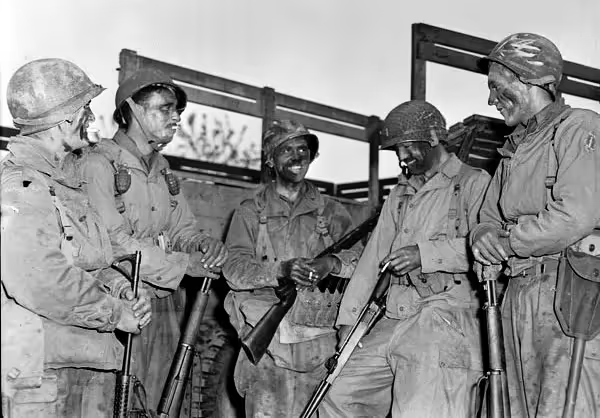
(Library and Archives Canada Photo, MIKAN No. 3378967)
(L-R): Pvt Dan Lemaire (5-2 & 6-2), Pfc Richard Stealey (6-2), Sgt Charles Shepard (6-2), Lt H.H. Raynor (5-2 & 1-2), Pfc James A. Jones (5-2 & 6-2), Forcemen of 5-2, First Special Service Force, preparing to go on an evening patrol in the Anzio beachhead, Operation Shingle, Italy, ca. 31 March 1944. The soldier on the left is carrying a .30 calibre M1941 Johnson Light Machine Gun (LMG) unique to the FSSF.
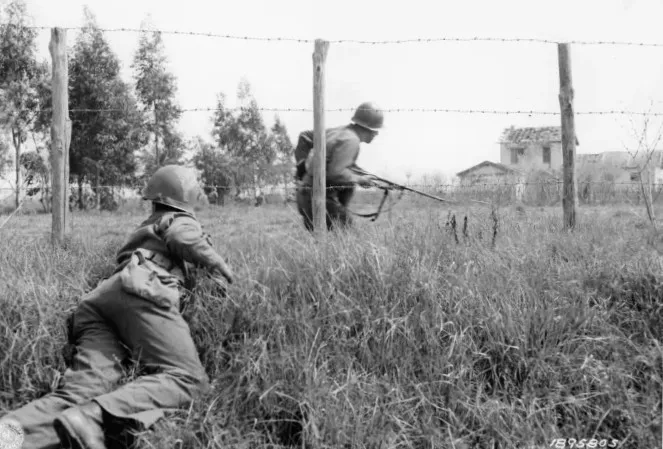
(National Archives Photo, Local Identifier Number: 111-SC-189580-S)
Infantry on Patrol in Italy. There is nothing in front of the Infantry in battle except the enemy. The Infantry leads the way to attack and bears the brunt of the enemy’s attack. The primary purpose of the Infantry is to close with the enemy in hand-to-hand fighting. Men of this Infantry patrol, one of the many that made possible the present offensive in Italy by feeling out the enemy and discovering his defensive strength, skirt a mine field along the barbed wire as they advance on a farmhouse containing Nazis, in the Anzio area, Italy. Fifth Army, April 14, 1944. 1st Special Service Force Patrol.
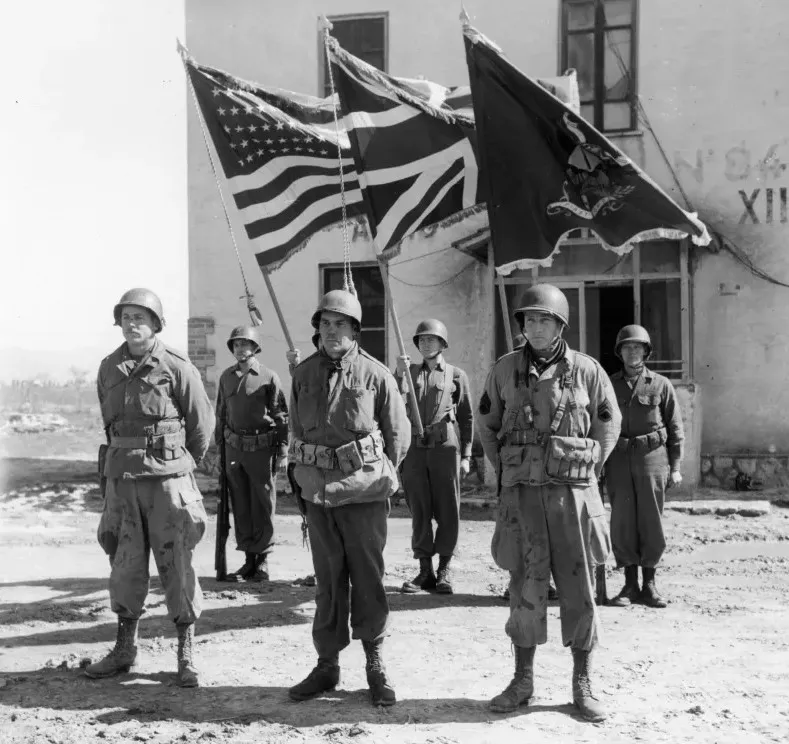
(National Archives Photo, Local Identifier Number: 111-SC-244751)
Nettuno Area, Italy. Three men of the 1st Special Service Force have been presented the Silver Star at their headquarters on the 3rd Division front. U.S. Fifth Army. March 14, 1944.

(Library and Archives Canada Photo, MIKAN No. 3378973)
L-R): Privates Willie.P. LeLievre (5-2) and Ludger E. Roussy (5-2), Forcemen of 5-2, First Special Service Force, with an .30 cal M41 Johnson light machine gun, Anzio beachhead, Italy, ca. 20-27 April 1944.
The FSSF spent 90 days in the Anzio beachhead, occupying defensive positions whihc made up a large part of the entire perimeter. They patrolled aggressively against the crack Hermann Goering Division opposite them. Replacements arrived during their time in the beachhead, and on 23 May 1944 the now-recovered FSSF moved forward again, leading the advance of VI Corps to Rome and the Advance to the Tiber in June.

(Author Photo)
.30 calibre M1941 Johnson Light Machine Gun (LMG), 4 Canadian Division Support Base Petawawa, Ontario.

(Library and Archives Canada Photo, MIKAN No. 3378694)
Forcemen of the First Special Service Force, milking a cow near Anzio Beach, 20 April 1944. The soldier doing the milking is wearing a V-42 Stiletto combat knife beside his .45 cal M1911 pistol.

(John Gibson Photo)
V-42 Stiletto combat knife, issued to the FSSF during the Second World War. Based on the Fairbairn-Sykes commando knife, the Fighting Commando Knife, Type V-42 used a narrow-profile, double-edged stiletto blade made of high carbon steel. The V-42 was primarily designed by officers of the FSSF, including its commanding officer, Lt. Colonel Robert T. Frederick, who desired a close-quarters combat knife. The blade's design has been attributed to Col. Frederick, who had seen the Fairbairn–Sykes fighting knife while serving in Britain. The thumb groove on the V-42's ricasso was designed to promote a flat grip with the thumb over the crossguard, which positioned the double-edged blade horizontally. In this manner a user could slash an opponent with either a forehand or backhand stroke, while ensuring that his blade would slip between the ribs when used in a thrust or stab.

(Library and Archives Canada Photo, MIKAN No. 3396041)
Lieutenant W.H. Langdon, carrying full kit, joins up with his unit, the First Special Service Force north of Venafro, Italy, January 1944.

(Library and Archives Canada Photo, MIKAN No. 3396063)
Canadian and First Special Service Force soldiers with captured automatic weapons in the Anzio beachhead, Italy, 20 April 1944. According to Ted Morin, there is a story about the colt shown in this picture. One night a patrol was returning, when they came upon a mare that had been killed, when it had stepped on a mine. As they drew closer, they noticed a small black colt nestled against it. A man picked up the colt and carried it back to safety, where they built a corral and shelter for it. Over the next two months, it was kept warm and dry, and cared for night and day. When the breakout occurred, arrangements were made to have "Anzio", the name it was given, to be transported by truck and follow the Force advance. In Rome, Anzio and the men were reunited. When the Force moved to San Albano, the colt went with them. There they came upon an Orphanage, for children, run by Catholic Nuns, and Anzio was turned over to the Nuns for the entertainment of the children.
The weapons captured by the FSSF include the following:

(Author Photo)
MP 40 (Maschinenpistole 40) 9-mm submachine gun (SMG), developed in Germany and used extensively by the Axis powers during the Second World War. This one is on display in the Canadian Military Engineer Museum, 5 Canadian Division Support Base Gagetown, New Brunswick.

(Author Photo)
MAB 38 (Moschetto Automatico Beretta Modello 1938), Modello 38, or Model 38 and its variants were a series of 9-mm official submachine guns of the Royal Italian Army introduced in 1938 and used during the Second World War. The guns were also used by the German, Romanian, and Argentine armies of the time. This one is on display in the New Brunswick Military History Museum (Woolastook), New Maryland, New Brunswick.

(Library and Archives Canada Photo, MIKAN No. 3509521)
Captured Italian 8-mm Breda M37 machine gun, being examined by Canadians near Syracuse, Italy, 11 August 1943.

(Library and Archives Canada Photo, MIKAN No. 3206400)
Entry of Allied Forces into Rome, 4 June 1944. The vehicles unit markings have been edited out by the official censor.
The FSSF saw continued action throughout the Mediterranean, at Monte Sammucro, Radicosa, and Anzio. For the final advance on Rome, the FSSF was given the honour of being the lead force in the assault and became the first Allied unit to enter the "Eternal City". Their success later continued in southern France and then at the France-Italian border. Often misused as line troops, the force suffered continuously high casualties until it was finally withdrawn from combat.
In August 1944, the Force was able to use its amphibious skills during the landings on islands flanking the invasion beaches in Southern France as part of Operation DRAGOON. The unit then fell under the operational control of the 1st Airborne Task Force, clearing the French coastline east to the Italian border. It was their last major mission, and in December 1944, with the need for specialized forces waning, the Force was disbanded. The Canadians went largely to the 1st Canadian Parachute Battalion, the Americans to the 474th Infantry (Separate) Regiment, or to US parachute units. The parachute-trained and combat tested Canadians of the FSSF were seen as a valuable asset for the 1st Canadian Parachute Battalion then training in England.

(Library and Archives Canada Photo, MIKAN No. 3963983)
Here are four of the main figures in the invasion of the French islands of Port Cros and Levant which preceded the invasion of Southern France by a few hours in August 1944. The photo was taken on the bridge of HMCS Prince Henry, a mother ship to Canadian assault craft. Left to right, Captain V.S. Godfrey, Victoria, BC; Rear Admiral T.E. Chandler, USN, Washington, D.C. whose pennant on the Canadian ship made her the flagship for the operation, which he commanded; Captain G.E. Maynard, a veteran of the Normandy invasion directly in charge of the Levant assault; and Colonel Edwin Walker, who commanded the First Special Service Force from June to Dec 1944, assaulted the islands. Shown in the background are two Canadian sailors, AB Les Cole of Belleville, Ontario and Leading Torpedo Operator Rod Harris of Calgary, Alberta.

(Library and Archives Canada Photo, MIKAN No. 3963973)
First Special Service Force preparing to take part in the assault on the French islands of Port Cros and Levant which preceded the invasion of Southern France by a few hours, August 1944.

(Library and Archives Canada Photo, MIKAN No. 3589291)
Sergeant G.A. Rainville, former Canadian member of the First Special Service Force, receiving the Silver Star from Brigadier-General E.F. Koenig, Commander of U.S. Forces in the United Kingdom, Canadian Repatriation Unit, England, 24 April 1945.
Generic CANADA shoulder titles. When Canadians returned to the Canadian Army after the FSSF was disbanded, some interesting mixes of insignia were worn. Some returned to their units and some transferred to 1 Canadian Parachute Battalion or its holding unit in the UK. Some wore an FSSF collar badge (officer or enlisted) as a cap badge on their headgear. The shiny vertical stripe on Sgt Rainville's lower left arm is a wound stripe. Canada did not issue a medal for being wounded.

(Library and Archives Canada Photo, MIKAN No. 3191549)
FSSF, LCol J.F.R. Akehurst CO 2 Bn & Sgt Tommy Prince, MM, London, 12 Feb 1945.

(DND Photo)
First Special Service Force paratrooper Tommy Prince, Canada's most decorated First Nations soldier.
Organization
The FSSF was outfitted entirely by the US, with uniforms, equipment and weapons. In some ways they were similarly outfitted to US parachute units, however, there were also major differences, as outlined below. The Force itself was equal to an over-strength Canadian Infantry Brigade. consisting of three "Regiments" each divided into two battalions.
First Special Service Force
First Regiment
1st Battalion, No. 1 Company, No. 2 Company, No. 3 Company.
2nd Battalion, No. 4 Company, No. 5 Company, No. 6 Company.
Second Regiment
1st Battalion, No. 1 Company, No. 2 Company, No. 3 Company.
2nd Battalion, No. 4 Company, No. 5 Company, No. 6 Company.
Third Regiment
1st Battalion, No. 1 Company, No. 2 Company, No. 3 Company.
2nd Battalion, No. 4 Company, No. 5 Company, No. 6 Company.
Service Battalion,
Maintenance Company, Service Company, Military Police Platoon, Forward Air Controllers.
Each "Regiment" of two battalions generally consisted of about 600 men at full strength, with companies of about 100. The Force was short on supply troops, although the integral Service Battalion was a unique concept at the time of its introduction in 1942. The goal was to have all non-combat personnel at the Brigade headquarters.
FSSF Company
HQ Platoon, 1st Platoon, 2nd Platoon, 3rd Platoon
The platoon commander (a lieutenant) would be armed most likely with a .30 calibre M1 carbine and .45 calibre Automatic Colt Pistol (ACP) M1911, and would have two sections under his command. The section was nominally comprised of twelve men led by a Staff Sergeant. Each of the two sections had a section leader armed with a .45 calibre Thompson submachine gun (SMG), a .30 calibre M1918 Browning Automatic Rifle (BAR) Gunner, nine .30 calibre semi-automatic M-1 Garand rifles, a .30 calibre M1941 Johnson Light Machine Gun (LMG), and either a 2.36 inch Bazooka man-portable recoiless rocket launcher, or a 60-mm M19 Mortar.

(Author Photo)
.30 calibre M1 carbine, on display in the New Brunswick Military History Museum, 5 Canadian Division Support Base Gagetown, New Brunswick.

(Author Photo)
.45 calibre Automatic Colt Pistol (ACP) M1911, on display in the New Brunswick Military History Museum, 5 Canadian Division Support Base Gagetown, New Brunswick.

(Author Photo)
.45 calibre Thompson submachine gun (SMG), on display in the New Brunswick Military History Museum, 5 Canadian Division Support Base Gagetown, New Brunswick. The M1928A1 had provisions for box and drum magazines. It had a Cutts compensator, cooling fins on the barrel, employed a delayed blowback action and its charging handle was on the top of the receiver. Shown with a .45 cal Colt M1911 automatic pistol and a .455 cal Webley & Scott Mk. VI revolver.

(Author Photo)
30 calibre M1918 Browning Automatic Rifle (BAR), on display in the New Brunswick Military History Museum, 5 Canadian Division Support Base Gagetown, New Brunswick.

(Author Photo)
.30 calibre semi-automatic M-1 Garand rifle, on display in the New Brunswick Military History Museum, 5 Canadian Division Support Base Gagetown, New Brunswick.

(Author Photos)
.30 calibre M1941 Johnson Light Machine Gun (LMG), Garrison Petawawa and Airborne Forces, 4 Canadian Division Support Base Petawawa, Ontario.

(PD-USGOV-MILITARY-ARMY Photo)
Soldier holding a 2.36-inch M1 Bazooka man-portable recoilless anti-tank rocket launcher, 31 Dec 1942.

(PD-USGOV-MILITARY-ARMY Photo)
60-mm M19 Mortar.
Support Units
As the FSSF was a light infantry unit, it required heavier support units on occasion. The FSSF arrived on the Anzio beachhead in Italy with the 456th Parachute Artillery Battalion attached as "semi-Permanent fire support. This battalion was comprised of three batteries, each equipped with four M1A1 75-mm pack howitzers. It also had an anti-tank platoon equipped with four M3A1 37-mm anti-tank guns.
Battalion Headquarters
Security Platoon equipped with two trucks and two .50 calibre Browning Heavy Machine Guns (HMG).

(Author Photo)
.50 calibre Browning Heavy Machine Gun (HMG), on display in the New Brunswick Military History Museum, 5 Canadian Division Support Base Gagetown, New Brunswick.
Signals Platoon, Supply Platoon and Maintenance Platoon. NB
Three 75-mm Batteries, each with two sections equipped with two jeeps and two M1A1 75-mm pack howitzers.

(Author Photo)
M1A1 75-mm pack howitzer, on display in the Royal Regiment of Canadian Artillery School, 5 Canadian Division Support Base Gagetown, New Brunswick.
Anti-Tank Platoon, equipped with four Jeeps and four M3A1 37-mm anti-tank (AT) Guns.
.avif)
(Author Photo)
M3A1 37-mm anti-tank Gun, on display in East Millinocket, Maine.

(IWM Photo, TR 1925)
An American Army Jeep passing a demolished bridge under repair by American Army Engineers, 16 June 1944. The Germans destroyed this bridge during their retreat from Rome.
Ranger Gun Company (Anzio)

(Library and Archives Canada Photo, MIKAN No. 3607690)
While engaged in the fighting at Anzio, Italy in April 1944, the First Special Service Force (FSSF) acquired a Gun Company from an American Ranger unit, "Darby's Rangers". This unit was equipped with four T30 Howitzer Motor Carriage halftracks equipped with a 75-mm M1897A4 howitzer, aka "French 75", similar to the ones shown in this photo in service with the Canadian Army in Italy in 1944.
The Rangers called them Darby’s Aces. Each gun shield was painted with a different suit of cards. The Forcemen took the half tracks to Normandy and became the 474th Infantry Regiment’s Cannon Company. Later equipped with M7 “Priests”.

(Author Photo)
3rd Cav Museum, M7 Priest 105-mm SP Gun on display at the 3rd Cavalry Museum, Fort Hood, Texas.
81st Reconnaissance Battalion
This battalion (part of the 1st US Armored Division) was sometimes used in support of the FSSF, and probably operated with one recce company in support of each FSSF battalion. The 81st Reconnaissance Battalion used M8 Greyhound armoured cars, M5A1 Stuart light tanks, the M19 60-mm mortar, and the 1/4 ton truck (both armed and unarmed).
Recce Company
Armoured Car Platoon, equipped with three M8 Greyhound armoured cars, three Jeeps with machine guns (MG), and three Jeeps each equipped with a 60-mm Mortar.

(Author Photo)
M8 Greyhound Light Armoured Scout Car, 1st Cavalry Museum, Fort Hood, Texas.

(US National Archives and Records Administration Photo)
Fifth Army jeeps caught in a rain swollen stream. Moments before the rain, the stream was only a few inches deep. Volterra Sector, Italy, 9 July 1944.
Light Tank Platoon, equipped with five M5A1 Light Tanks

(Author Photo)
M5A1 Light Tank, 3rd Cavalry Museum, Fort Hood, Texas.
Sardinian Mule Company

(US Army Photo)
Soldiers adjust the straps that secure a machine gun to the back of a mule for transport.
Weasel
The T-15, an early snowmobile vehicle capable of carrying four men, was used by the FSSF in the Aleutians, and a larger vehicle known as the T-24 (later standardized as the M29) was used by the Force in Italy, although in limited numbers.
In January 1944, 12 of the 100 T-24 Weasels the Force had brought to Italy were uncrated for the first time. The Force found it preferred mules in much of the terrain it found in Italy, due to the rugged hills they were forced to operate in. A few were used by the Canadian Army in Europe.

(Author Photo)
M29 Weasel on display at CFB Petawawa, Ontario.
Disbandment, Menton, France
On 5 December 1944, in the town of Menton in southern France, the First Special Service Force was disbanded. Its battle honours included Monte Camino, Monte La Difensa, Monte La Remetanea, Monte Majo, Anzio, Rome, Advance to the Tiber, Italy 1943–44, Southern France and Northwest Europe. The Canadians rejoined their home units and the Americans were assigned to either Airborne units or the newly formed 474th Infantry Regiment. Their Commander, Frederick, became the youngest Major-General ever in the American army, at the age of 37, and took command of the 45th Division.
Battle Honours As Awarded By The American Government
Pacific Theater
Aleutians Campaign
Kiska-Little Kiska August 15-19, 1943
Segula Island August 17, 1943
Mediterranean Theater
Naples-Foggia Campaign
Monte la Difensa December 3-6, 1943
Monte la Remetanea December 6-9, 1943
Height 720 (Monte Sammucro) December 25, 1943
Radicosa January 4, 1944
Monte Majo January 6, 1944
Monte Vischiataro January 8, 1944
Mussolin Canal (Anzio) February 2 - May 10, 1944
Monto Arrestino May 25, 1944
Rocca Massima May 27, 1944
Colle Ferro June 2, 1944
Rome-Arno Campaign
Rome June 4, 1944
Southern France Campaign
Ille d'Hyeres August 14-17, 1944
Grasse August 27, 1944
Villeneuve-Loubet August 30, 1944
Vence September 1, 1944
Drap September 3, 1944
L'Escarene September 5, 1944
La Turbie September 6, 1944
Menton September 7, 1944
Battle Honours as Awarded by the Canadian Government
Monte Camino, Monte la Difensa, Monte la Remetanea, Monte Majo, Height 720 (Monte Samucro),
Radicosa, Monte Vischiataro, Anzio, Rome, Advance to the Tiber, Monte Arrestino, Rocca Massima,
Colle Ferro, Itally 1943-1944, Iles d'Hyeres, Grasse, Villeneuve-Loubet, Vence, Drap, L'Escarene,
La Turbie, Menton, Southern France, Franco-Italian Border.
(Data courtesy of Alistair Neely. For tremendous detail on the FSSF, visit his web page at: http://www.execulink.com/~kiska/FSSFHomepage.index.html)
"The First Special Service Force made no distinctions when it went into battle - its men had the common cause of freedom at their side and the common denominator of courage in their hearts. They were neither Canadians nor Americans. They were in General Eisenhower's term, liberators." President Ronald Reagan.
Major-General Robert T. Frederick

(USGOV-PD Photo)
Major-General Robert Tryon Frederick, Distingushed Service Cross (DSC), Distinguished Service Medal (DSM), Silver Star, Legion of Merit and Bar, Bronze Star and Bar, Purple Heart (8). (14 March 1907 - 29 November 1970)
Major-General Frederick was a highly decorated American combat commander during the Second World War. He commanded the 1st Special Service Force, the 1st Airborne Task Force and the 45th Infantry Division. When jumping began for the FSSF, he was one of the very first Officers, if not the first, to jump. He thought that it was important to set the example for his men. There is a legend that, after only 10 minutes of instruction, he said, to the Instructor: ''enough of that, lets go''. Another legend was told that he made the jump in his slippers. In fact, because his Force jump boots had not arrived, he made the jump in his shoes.
On 23 June 1944, Brigadier-General Frederick upon leaving the Force was promoted to Major-General and given the task of raising the 1st Airborne Task Force in preparation for the invasion of southern France, on "Operation Dragoon". On 15 Aug 1944, in pitch darkness, he was the first to jump out of his plane. When he landed he reinjured a 10'' wound, that had not completely healed. Frederick always lead from the front. (Ted Morin)
There is a bronze Memorial to Lieutenant Colonel Robert T. Frederick, mounted at the entrance to 4 Canadian Division Support Base Petawawa, Ontario.
The success, esprit and discipline of FSSF became a template for building modern special forces worldwide.
Most of the data presented here has been drawn from Wikipedia, with extracts from:
Adleman, Robert H. The Devil's Brigade. (Toronto, ON: Bantam Books of Canada, 1967).
Burhans, Robert D. The First Special Service Force: A War History of the North Americans 1942-1944. (Nashville, Tennessee: Battery Press, 1981).
Horn, Bernd and Michel Wyczynski Hook-Up! The Canadian Airborne Compendium: A Summary of Major Airborne Activities, Exercises and Operations, 1940-2000. (Vanwell Publishing Ltd., St. Catharine's, Ontario, 2003).
Peppard, Herb. The Lighthearted Soldier: A Canadian's Exploits with the Black Devils in WW II. (Halifax, NS: Nimbus Publishing Ltd., 1994).
Ross, Robert Todd. The Supercommandos: First Special Service Force, 1942-1944 An Illustrated History, Atglen, PA: Schiffer, Publishing Ltd., 2000.

